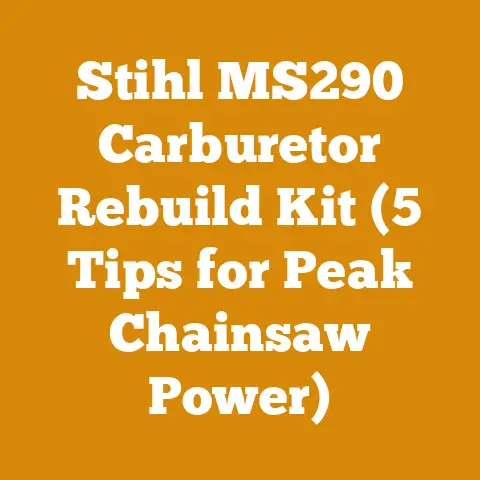Patio Enclosures for Wood Storage (Quick Setup Tips for Firewood)
Let me tell you about the time I almost lost a winter’s worth of firewood. I had meticulously stacked it, proud of my handiwork, only to have a torrential downpour soak the entire pile. The wood became heavy, moldy, and practically unusable. That experience taught me the critical importance of proper firewood storage, and it’s what ignited my passion for finding the best solutions – solutions like patio enclosures. I’ve since experimented with numerous setups, learning what works, what doesn’t, and how to build a system that protects your investment in firewood, no matter the weather. This guide is born from those hard-won lessons, and it’s designed to help you create the perfect patio enclosure for your firewood storage needs.
Patio Enclosures for Wood Storage: Quick Setup Tips for Firewood
Firewood represents a significant investment of time, money, and effort. Protecting it from the elements is crucial to ensure it burns efficiently and provides optimal heat. A well-designed patio enclosure offers an effective and often aesthetically pleasing solution.
Understanding the Importance of Proper Firewood Storage
Before diving into setup tips, let’s quickly recap why proper storage is so vital.
- Preventing Rot and Mold: Wet firewood is a breeding ground for fungi.
- Maintaining Heat Value: Dry wood burns hotter and cleaner. Wet wood wastes energy evaporating moisture.
- Pest Control: A dry, well-ventilated stack is less attractive to insects and rodents.
- Ease of Use: Dry wood is easier to light and handle.
Choosing the Right Patio Enclosure Type
There are several types of patio enclosures suitable for firewood storage. Your choice will depend on your budget, available space, and desired level of protection.
Open-Sided Enclosures
These offer basic protection from rain and snow while allowing for ample airflow.
- Pros: Cost-effective, easy to build, excellent ventilation.
- Cons: Limited protection from wind-driven rain and snow.
- Materials: Lumber (pressure-treated is recommended), corrugated metal or plastic roofing.
Partially Enclosed Structures
These offer more protection than open-sided enclosures by incorporating partial walls.
- Pros: Good balance of protection and ventilation.
- Cons: More complex to build than open-sided enclosures.
- Materials: Lumber, siding (wood, vinyl, or metal), roofing.
Fully Enclosed Structures
These provide the highest level of protection but may require more planning and investment.
- Pros: Maximum protection from the elements.
- Cons: Can trap moisture if not properly ventilated, more expensive to build.
- Materials: Lumber, siding, roofing, ventilation system (vents or louvers).
Repurposed Structures
Consider repurposing existing structures like sheds or carports. This can be a very cost-effective solution.
- Pros: Can be very affordable, environmentally friendly.
- Cons: May require modification to provide adequate ventilation.
- Materials: Existing structure, lumber for modifications, roofing repairs.
Quick Setup Option: Portable Firewood Racks with Covers
For a truly quick setup, consider portable firewood racks with waterproof covers. I’ve used these in a pinch and they work surprisingly well for smaller quantities of wood.
- Pros: Extremely easy to set up, portable, relatively inexpensive.
- Cons: Limited capacity, may not be as durable as permanent structures.
- Materials: Metal rack, waterproof cover.
Planning Your Patio Enclosure: Key Considerations
Before you start building, take some time to plan your enclosure. This will save you time and money in the long run.
Determining Size and Capacity
Calculate the amount of firewood you need to store for the winter. A cord of wood is a stack that measures 4 feet high, 4 feet wide, and 8 feet long (128 cubic feet). Consider how many cords you typically burn in a season and factor in some extra space. I usually aim for at least 1.5 cords, just to be safe.
- Rule of Thumb: Allow approximately 60-70 cubic feet of storage space per cord of split firewood, accounting for stacking inefficiencies.
- Example: If you burn 2 cords, plan for an enclosure with at least 120-140 cubic feet of storage capacity.
Site Selection
Choose a location that is:
- Well-drained: Avoid low-lying areas where water can accumulate.
- Sunny: Sunlight helps to dry the wood.
- Accessible: Make sure it’s easy to access the enclosure from your house and your wood source.
- Away from Structures: Maintain a safe distance from your house and other buildings to prevent fire hazards. The National Fire Protection Association (NFPA) recommends a minimum of 10 feet.
Ventilation
Adequate ventilation is crucial to prevent moisture buildup.
- Open-Sided Enclosures: Naturally ventilated.
- Partially and Fully Enclosed Structures: Incorporate vents or louvers near the top and bottom of the structure to promote airflow. Aim for a vent area of at least 1 square foot per 100 cubic feet of enclosure volume.
Foundation
A solid foundation will prevent the enclosure from settling and warping.
- Gravel Base: A simple and effective option for open-sided enclosures. Lay down a 4-6 inch layer of gravel to promote drainage.
- Concrete Slab: Provides a more stable and durable foundation for larger enclosures.
- Concrete Blocks or Pavers: A good compromise between gravel and a full concrete slab.
Step-by-Step Guide to Building an Open-Sided Patio Enclosure
This is a simple and cost-effective option that provides good protection and ventilation. I’ve built several variations of this design over the years, and it’s always a reliable choice.
Materials List
- Pressure-treated lumber:
- 4×4 posts (8 feet long): 4
- 2×4 lumber (8 feet long): 12
- 2×6 lumber (8 feet long): 4
- Corrugated metal or plastic roofing sheets: Quantity depends on the size of your enclosure.
- Fasteners: Screws, nails, or bolts suitable for outdoor use.
- Gravel: Enough to create a 4-6 inch base.
Tools List
- Shovel
- Level
- Measuring tape
- Saw (circular saw or hand saw)
- Drill/driver
- Hammer
- Safety glasses
- Gloves
Step 1: Preparing the Foundation
- Clear the site of any vegetation and debris.
- Excavate the area to a depth of 4-6 inches.
- Fill the excavated area with gravel and compact it. Ensure the base is level using a level.
Step 2: Setting the Posts
- Dig post holes at each corner of the enclosure. The holes should be deep enough to bury the posts at least 2 feet deep.
- Place the 4×4 posts in the holes and ensure they are plumb (perfectly vertical) using a level.
- Backfill the holes with concrete or compacted gravel to secure the posts.
Step 3: Building the Frame
- Attach the 2×6 lumber to the posts at the top to create a sturdy frame. Use screws or bolts to ensure a strong connection.
- Attach the 2×4 lumber horizontally to the posts to create the sides of the enclosure. Space the 2x4s evenly, leaving gaps for ventilation. I typically space them about 12 inches apart.
Step 4: Installing the Roofing
- Attach the corrugated metal or plastic roofing sheets to the 2×6 frame. Overlap the sheets to prevent leaks.
- Use roofing screws with rubber washers to secure the sheets.
Step 5: Finishing Touches
- Inspect the enclosure for any loose connections or sharp edges.
- Add a gravel ramp at the entrance for easy access.
Modifying a Shed for Firewood Storage
If you have an existing shed, converting it into firewood storage can be a quick and cost-effective solution. I helped a friend do this a few years ago, and it worked out great. The key is to ensure adequate ventilation.
Assessing the Shed
- Size: Determine if the shed is large enough to store your firewood.
- Condition: Check for any structural damage or leaks.
- Ventilation: Evaluate the existing ventilation and plan for improvements.
Modifications
- Repair any leaks: Patch the roof and walls to prevent water from entering.
- Improve ventilation: Install vents or louvers in the walls or roof. Consider adding a small fan to circulate air if necessary.
- Raise the floor: If the floor is directly on the ground, raise it with concrete blocks or a gravel base to prevent moisture from wicking up into the wood.
- Add shelving: Build shelves to maximize storage space and improve airflow around the wood.
Enhancing Ventilation in Enclosed Structures
Proper ventilation is critical in enclosed or partially enclosed structures. Without it, moisture can build up and promote rot and mold.
Types of Ventilation
- Passive Ventilation: Relies on natural airflow. This includes vents, louvers, and gaps in the walls.
- Active Ventilation: Uses fans to circulate air. This is more effective but requires electricity.
Placement of Vents
- Low Vents: Allow cool, dry air to enter the enclosure.
- High Vents: Allow warm, moist air to escape.
- Opposite Walls: Place vents on opposite walls to promote cross-ventilation.
Sizing Vents
- Rule of Thumb: Aim for a vent area of at least 1 square foot per 100 cubic feet of enclosure volume.
- Example: A 10x10x8 foot shed (800 cubic feet) would require at least 8 square feet of vent area.
Selecting the Right Wood for Firewood
The type of wood you burn significantly impacts heat output, burn time, and smoke production.
Hardwoods vs. Softwoods
- Hardwoods: Dense woods like oak, maple, and ash burn hotter and longer than softwoods.
- Softwoods: Woods like pine, fir, and spruce are easier to ignite but burn faster and produce more smoke.
Popular Firewood Species
- Oak: High heat output, long burn time. My personal favorite!
- Maple: Good heat output, moderate burn time.
- Ash: Easy to split, good heat output.
- Birch: Burns quickly, produces a pleasant aroma.
- Pine: Easy to ignite, good for kindling.
Wood Density and Heat Value
Wood density is a good indicator of heat value. Denser woods contain more energy per unit volume. Here’s a table showing the approximate heat value of some common firewood species:
| Wood Species | Approximate Heat Value (BTU per Cord) |
|---|---|
| Oak | 24-30 million |
| Maple | 20-25 million |
| Ash | 20-24 million |
| Birch | 20 million |
| Pine | 12-18 million |
Note: BTU (British Thermal Unit) is a measure of heat energy.
Seasoning Firewood: The Drying Process
Seasoning is the process of drying firewood to reduce its moisture content. This is essential for efficient burning and minimizing smoke.
Why Seasoning is Important
- Increased Heat Output: Dry wood burns hotter and cleaner.
- Reduced Smoke: Wet wood produces excessive smoke.
- Easier Ignition: Dry wood is easier to light.
- Prevention of Creosote Buildup: Creosote is a flammable substance that can accumulate in chimneys and cause fires.
Seasoning Time
- Hardwoods: Typically require 6-12 months of seasoning.
- Softwoods: May season in as little as 3-6 months.
Indicators of Well-Seasoned Wood
- Cracks in the end grain: These indicate that the wood has dried and shrunk.
- Lightweight: Seasoned wood is significantly lighter than green wood.
- Dull thud when struck: Seasoned wood produces a dull thud, while green wood produces a solid sound.
- Moisture content: Use a moisture meter to measure the moisture content. Aim for a moisture content of 20% or less.
Seasoning Techniques
- Stacking: Stack the wood in a single row, off the ground, and under cover.
- Sun and Wind: Expose the wood to sun and wind to promote drying.
- Airflow: Ensure good airflow around the wood.
Stacking Firewood for Optimal Drying and Storage
Proper stacking is crucial for efficient drying and maximizing storage space.
Stacking Methods
- Crisscross Stacking: Stacking the wood in alternating directions to create a stable and well-ventilated pile.
- Holz Hausen: A circular stack that promotes good airflow and stability. I find this method particularly aesthetically pleasing.
- Linear Stacking: Stacking the wood in a single row, slightly off the ground.
Tips for Stacking
- Elevate the wood: Use pallets, concrete blocks, or scrap lumber to raise the wood off the ground.
- Leave gaps: Leave small gaps between the pieces of wood to promote airflow.
- Stack tightly: Stack the wood tightly to maximize storage space.
- Cover the top: Cover the top of the stack with a tarp or roofing material to protect it from rain and snow.
Tools for Firewood Preparation
Having the right tools can make firewood preparation safer and more efficient.
Chainsaws
- Types: Gas-powered, electric, and battery-powered.
- Size: Choose a chainsaw that is appropriate for the size of the logs you will be cutting. A 16-18 inch bar is suitable for most firewood applications.
- Safety: Always wear safety glasses, gloves, hearing protection, and chaps when operating a chainsaw.
Log Splitters
- Types: Manual, hydraulic, and electric.
- Tonnage: Choose a log splitter with sufficient tonnage for the type of wood you will be splitting. 20-25 tons is sufficient for most firewood applications.
- Safety: Always wear safety glasses and gloves when operating a log splitter.
Axes and Mauls
- Axes: Used for felling trees and limbing branches.
- Mauls: Used for splitting logs.
- Safety: Always wear safety glasses and gloves when using an axe or maul.
Wedges
- Purpose: Used to split logs that are too large or difficult to split with an axe or maul.
- Types: Steel and composite.
- Safety: Always wear safety glasses and gloves when using wedges.
Safety Gear
- Safety Glasses: Protect your eyes from flying debris.
- Gloves: Protect your hands from cuts and splinters.
- Hearing Protection: Protect your ears from the noise of chainsaws and other power tools.
- Chaps: Protect your legs from chainsaw injuries.
- Steel-Toed Boots: Protect your feet from falling logs.
Safety Procedures for Firewood Preparation
Firewood preparation can be dangerous if proper safety procedures are not followed.
General Safety Tips
- Wear appropriate safety gear.
- Work in a well-lit area.
- Keep your work area clear of obstacles.
- Never work alone.
- Take breaks to avoid fatigue.
- Know your limits.
Chainsaw Safety
- Read the chainsaw’s owner’s manual before operating it.
- Inspect the chainsaw before each use.
- Start the chainsaw on the ground, away from your body.
- Use a firm grip on the chainsaw.
- Keep the chainsaw chain sharp.
- Never cut above your head.
- Be aware of the risk of kickback.
Log Splitter Safety
- Read the log splitter’s owner’s manual before operating it.
- Inspect the log splitter before each use.
- Wear safety glasses and gloves.
- Keep your hands clear of the splitting wedge.
- Never operate the log splitter on an uneven surface.
- Never split wood that is too large for the log splitter.
Axe and Maul Safety
- Wear safety glasses and gloves.
- Use a firm grip on the axe or maul.
- Keep your feet clear of the splitting area.
- Swing the axe or maul with a controlled motion.
- Never swing the axe or maul towards your body.
Troubleshooting Common Firewood Storage Problems
Even with the best planning, you may encounter problems with your firewood storage.
Mold and Rot
- Problem: Mold and rot indicate excessive moisture.
- Solution: Improve ventilation, remove affected wood, and consider using a fungicide.
Insect Infestation
- Problem: Insects can damage firewood and spread to your home.
- Solution: Inspect firewood regularly, remove infested wood, and consider using an insecticide.
Slow Drying
- Problem: Firewood is not drying quickly enough.
- Solution: Improve ventilation, expose the wood to more sunlight, and consider splitting the wood into smaller pieces.
Stack Instability
- Problem: The firewood stack is unstable and prone to collapsing.
- Solution: Restack the wood using a more stable method, such as crisscross stacking or Holz Hausen.
Estimating Firewood Needs
Accurately estimating your firewood needs is crucial for ensuring you have enough fuel for the winter. I always err on the side of caution and get a little extra.
Factors to Consider
- Climate: Colder climates require more firewood.
- Heating Efficiency: A well-insulated home requires less firewood.
- Wood Stove Efficiency: A more efficient wood stove requires less firewood.
- Burning Habits: How often and how long you burn firewood will affect your consumption.
Estimating Methods
- Historical Data: Track your firewood consumption from previous years.
- Online Calculators: Use online firewood calculators to estimate your needs based on your location, home size, and heating habits.
- Rule of Thumb: As a general guideline, a cord of wood will heat an average-sized home for approximately 1-2 months in a cold climate.
Firewood Storage and Local Regulations
Be aware of any local regulations regarding firewood storage.
Common Regulations
- Distance from Structures: Many municipalities require firewood to be stored a certain distance from buildings to prevent fire hazards.
- Stacking Height: Some regulations limit the height of firewood stacks.
- Pest Control: Some regulations require firewood to be treated for pests.
Checking Local Regulations
- Contact your local municipality or fire department.
- Check your homeowner’s association rules.
Sustainable Firewood Harvesting
Consider the environmental impact of your firewood harvesting practices.
Sustainable Practices
- Harvest from dead or fallen trees.
- Avoid harvesting from old-growth forests.
- Plant new trees to replace those that are harvested.
- Use efficient wood-burning appliances.
Benefits of Sustainable Harvesting
- Protects forests.
- Reduces carbon emissions.
- Conserves natural resources.
Alternative Firewood Options
If you don’t have access to traditional firewood, consider alternative options.
Compressed Wood Logs
- Pros: Easy to store, burns hot and clean.
- Cons: More expensive than traditional firewood.
Wood Pellets
- Pros: Very efficient, low emissions.
- Cons: Requires a pellet stove.
Biofuel Bricks
- Pros: Made from recycled materials, burns hot and clean.
- Cons: Can be difficult to find.
Final Thoughts
Creating the perfect patio enclosure for firewood storage is an investment that pays off in the long run. By following these tips, you can protect your firewood from the elements, ensure efficient burning, and enjoy a warm and cozy winter. Remember to prioritize safety, plan carefully, and choose the right materials for your needs. Now, get out there and build that enclosure!






